 |
Bradley & Co. Ltd
(Beldray)
Mount Pleasant, Bilston |
 |
2. The Company's Early Range of Goods
These illustrations show something of the type and range
of goods the company was producing, not all of them perhaps from the
very beginning. The illustrations are taken from two catalogues
issued by the company, neither of which is dated. But they seem to
be of similar date. Since both make reference to the company's
separate catalogue of art metalware they are probably post 1903; and
they both have the appearance of being pre-1914. No
all the products listed in the catalogue are shown here but the main
categories and some others are covered.
The goods tell us not only what Bradley's were making
but also tell us something of life at the time.
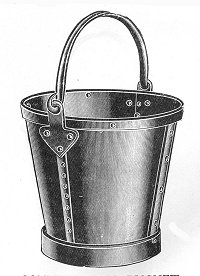 |
The catalogues start with buckets, so we might as well.
There are about 15 different buckets listed, differing in
weight, size and construction; and most of them are
available in a range of sizes too. They are all
described as galvanised. This one is called the
Contractor's Bucket and is particularly heavily made.
There are also buckets named as ship's buckets, milk buckets
and soap or lard buckets (whatever they are). They all
look pretty similar to the untrained eye. |
| There are three sorts of fire buckets. This one
has a rounded base with a rounded bar at the bottom: "This
bucket cannot be used for ordinary purposes owing to the
shape of the bottom".
At least this reminds us that by this time, thanks to
sheet metal, buckets were plentiful. In medieval and
later times they had been surprisingly rare - and fire
fighting was much hampered by lack of them. |
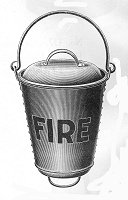 |
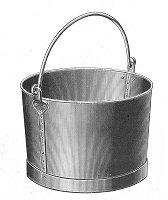 |
This is a milk bucket. It would have replaced the
traditional staved, wooden milking pail. |
| And this is a well bucket. There are different
stories as to the reason for its design. Some say that
it prevented the bucket getting trapped when thrown into the
well; others say it made the bucket easier to fill when it
reached the water. Perhaps it did both.
Bradley's do not explain. They were not the only
makers of this design. |
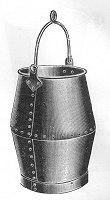 |
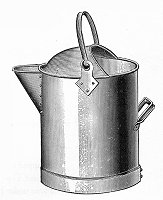 |
There are a couple of beer or water cans. This one
is the Irish half covered beer can. |
| This is the galvanised bungalow bath "specially designed
for small villa or cottage property as an efficient
substitute for a fixed bath". This is the tapered
pattern; there is also an equal-ended pattern. |
 |
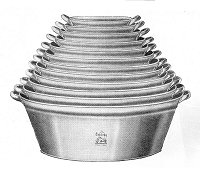 |
And these are oval baths. "A nest of Beldray baths
in your show room will assist your salesmen to ensure
increased turnover in this live selling line".
At this time most people did not have fixed baths and
many a house and cottage had "tin baths" hanging up on a
wall outside, to be taken inside when needed. |
| Among the coal scoops are a kitchen scoop and this
London scoop, presumably intended for a living room.
The Victorians were much concerned with the design of coal
scuttles for living rooms and produced some every elaborate
ones. Bradley's version makes a rather minimal style
statement - but it is available either galvanised or
japanned black. |
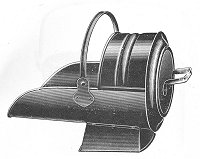 |
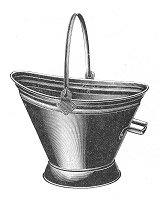 |
This is an example of a Waterloo coal scoop, of which
Bradley's offered four designs, all pretty similar - and all
pretty much like other company's Waterloo scoops.
Bradley's were making Waterloo scoops at least until the
1930s - as you can see elsewhere on these pages. |
| Coal was a fairly expensive commodity and a grate would
need emptying and cleaning at least once a day. So
this is a cinder sifter with a built in riddle which enabled
you to sift the clinker from the ash and re-use the clinker
by mixing it with fresh coal; and then carry the ash outside
for use on paths or for soil improvement.
Note that the label shown would be a paper label.
Bradley's do not seem to have impressed "Beldray" on their
galvanised and japanned goods at this time. |
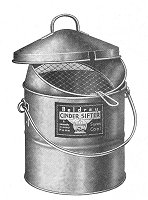 |
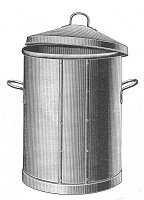 |
There are several different types of dust bins or
garbage bins, square, round and D shaped. This is the
"Corporation Pattern" - "as adopted by many municipalities
and urban districts throughout the country".
In use for decades these heavy and hard to lift and carry
bins make the wheelie bin look like a wonder of modern
design and manufacture. |
| There are several "earth closet pans" or "pails".
The earth closet had a system whereby, once you pulled the
handle, a layer of earth would be released from a storage
box and would descend into, and cover, whatever was in the
pail. It was not, of course, anything like as hygienic
in the house as the water closet but, before main sewers
came along, was probably far more environmentally friendly. |
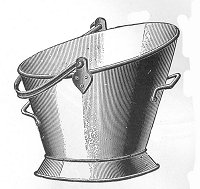 |
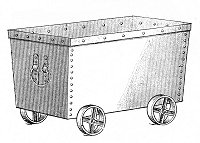 |
Several of the pans offered are large, as was this
wheeled one. Placed in a suitably constructed
lavatory, it could be wheeled out by the night soil men and
either emptied and replaced or swapped for an empty one. |
| The Do it All mop pail was a standard item in most
households as well as in workplaces. They would have
been made by Bradley's until late in the 20th century. |
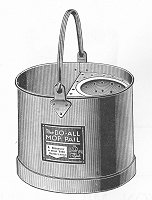 |
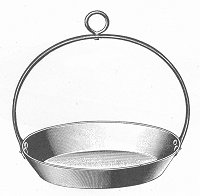 |
Bradley's offered a number of frying pans, with tubular
handles made from pressed sheet metal, rather than from the
cast iron tube used by, for example, Sankeys. This
hanging fry pan reminds us that this was a time of open
fires and gas ovens with hobs were only just coming in. |
| "Devon Milk Scalders" came in three sizes. But
there was probably not much call for them outside the dairy
industry of the west, where they were needed to make clotted
cream. |
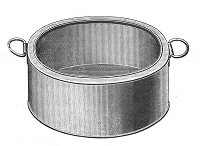 |
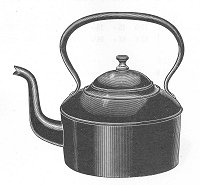 |
The catalogues contain a page of copper kettles - all of
a rather plain design - but we will deal with these on the
page about Art Metalware.
Meanwhile there are two tinplate kettles. This is
the "Perfection" kettle, japanned outside, tinned inside
with "spout raised above top of kettle - not liable to boil
over". |
| This kettle, also of seamless japanned construction
costs the same as the Perfection but doe not glory in a
name. The Perfection was available in sizes from 2
pints to 8 pints but this nameless wonder could be had in
sizes up to 16 pints. |
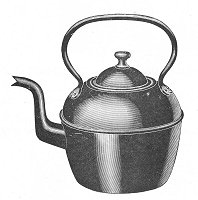 |
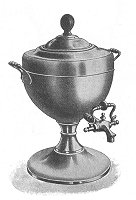 |
Oddly, perhaps, these urns only went up to 16 pints in
size too. But they were classier objects altogether.
This one, the Ideal, was made in polished copper with cast
brass handles and tap. |
| This urn, the Triumph, was made of the same materials
but was "specially strong in build". In both cases
"Inscription plates can be attached", prices "on receipt of
details of required lettering". |
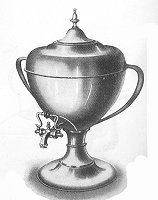 |
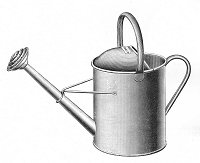 |
There is only one style of watering can - the item which
was to become one of Beldray's best known, at least in the
modern antiques trade. But it came in eight sizes,
from 3/4th gallon to 4 gallons; with two styles of spout;
and copper roses extra. |
| There are four types of barrow in one catalogue and none
in the other. But barrows certainly cropped up later
in Bradley's history and with some success. This is
the Navvy Barrow - the Garden Barrow was a much lighter
object. |
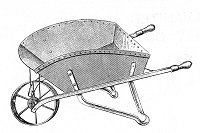 |
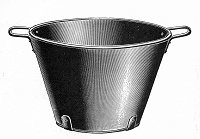 |
This is a turnip skip. It is one of several.
One can only suppose that they were for general farm use,
not just for turnips, however important those unpleasant
vegetables were. |
| This rice bowl would have been almost entirely for
export, probably through London factors. |
 |
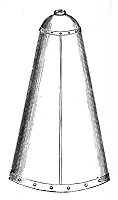 |
This sugar mould, one of several in the catalogue, would
also have been mainly for export, mostly to the Caribbean. |
| This plain looking object is a cassada pan. Large
numbers of such pans were used in South America in the
production of tapioca and were made by several local
companies. |
 |
|




























